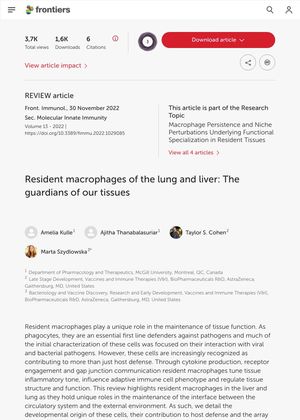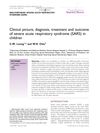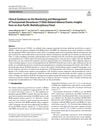Resident Macrophages of the Lung and Liver: The Guardians of Our Tissues
November 2022
in “
Frontiers in Immunology
”
macrophages alveolar macrophages interstitial macrophages immune surveillance anti-microbial defense iron homeostasis cholesterol metabolism hepatic tissue repair non-alcoholic steatohepatitis alcoholic steatohepatitis autoimmune hepatitis toxic liver injury pulmonary alveolar proteinosis asthma chronic obstructive pulmonary disease cystic fibrosis NASH ASH COPD

TLDR Lung and liver macrophages protect our tissues and their dysfunction can cause various diseases.
The document discusses the role of tissue-resident macrophages, long-lived innate immune cells, in the lung and liver. These cells, established during embryogenesis and maintained through self-renewal, are known for their ability to phagocytose debris and pathogens and present antigens to direct adaptive immunity. In the liver, they perform functions including immune surveillance, anti-microbial defense, clearance of cellular debris and metabolites, maintaining iron homeostasis, regulating cholesterol metabolism, and hepatic tissue repair. In the lungs, Alveolar Macrophages (AMs) and Interstitial Macrophages (IMs) maintain tissue homeostasis, with AMs removing debris and preventing excess inflammation, and IMs contributing to immunoregulation. Impaired function of these macrophages can lead to diseases like non-alcoholic steatohepatitis, alcoholic steatohepatitis, autoimmune hepatitis, toxic liver injury, pulmonary alveolar proteinosis, asthma, chronic obstructive pulmonary disease (COPD), and cystic fibrosis. The document suggests that understanding the roles of these macrophages could lead to potential therapeutic strategies for these conditions.



